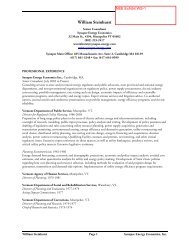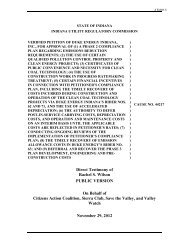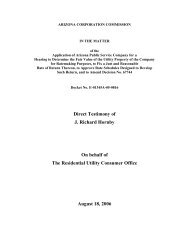Best Practices in Energy Efficiency Program Screening - Synapse ...
Best Practices in Energy Efficiency Program Screening - Synapse ...
Best Practices in Energy Efficiency Program Screening - Synapse ...
Create successful ePaper yourself
Turn your PDF publications into a flip-book with our unique Google optimized e-Paper software.
Low-Income New Construction: the purpose of this program is to capture lost<br />
opportunities, encourage the construction of energy-efficient homes, and drive<br />
the market to one <strong>in</strong> which new homes are mov<strong>in</strong>g towards net-zero energy.<br />
Small Commercial and Industrial (C&I) Retrofit: this program focuses on<br />
comprehensive gas and electric energy efficiency opportunities associated with<br />
mechanical, electrical, and thermal systems <strong>in</strong> exist<strong>in</strong>g commercial, <strong>in</strong>dustrial,<br />
governmental and <strong>in</strong>stitutional build<strong>in</strong>gs. It provides technical assistance and<br />
<strong>in</strong>centives to encourage retrofitt<strong>in</strong>g of equipment that cont<strong>in</strong>ues to function, but is<br />
outdated and <strong>in</strong>efficient, and can be replaced with a premium efficient product.<br />
Large C&I Retrofit: this program focuses on comprehensive gas and electric<br />
energy efficiency opportunities associated with mechanical, electrical, and<br />
thermal systems <strong>in</strong> exist<strong>in</strong>g commercial, <strong>in</strong>dustrial, governmental and <strong>in</strong>stitutional<br />
build<strong>in</strong>gs. It provides technical assistance and <strong>in</strong>centives to encourage<br />
retrofitt<strong>in</strong>g of equipment that cont<strong>in</strong>ues to function, but is outdated and <strong>in</strong>efficient,<br />
and can be replaced with a premium efficient product.<br />
C&I New Construction: this program is designed to optimize the efficiency of<br />
equipment, build<strong>in</strong>g design and systems <strong>in</strong> new construction and renovation of<br />
commercial, <strong>in</strong>dustrial, <strong>in</strong>stitutional and government facilities. The focus is on<br />
offer<strong>in</strong>g a comprehensive set of electric and gas efficiency options that are<br />
specific to the needs of each unique facility. The program also targets the brief<br />
w<strong>in</strong>dow of opportunity to <strong>in</strong>stall premium grade replacements when equipment<br />
fails or is near the end of its useful life.<br />
Avoided Costs Assumptions<br />
Introduction<br />
The avoided cost assumptions used by the New England utility are based on <strong>Synapse</strong>’s<br />
Avoided <strong>Energy</strong> Supply Costs <strong>in</strong> New England: 2011 Report (AESC Study). The AESC<br />
Study provides projections of marg<strong>in</strong>al energy supply costs that will be avoided due to<br />
reductions <strong>in</strong> the use of electricity, natural gas, and other fuels result<strong>in</strong>g from energy<br />
efficiency programs offered to customers throughout New England (<strong>Synapse</strong> 2011).<br />
The AESC Study provides estimates of avoided costs for program adm<strong>in</strong>istrators<br />
throughout New England to support their <strong>in</strong>ternal decision-mak<strong>in</strong>g and regulatory fil<strong>in</strong>gs<br />
for energy efficiency program cost-effectiveness analyses. Ultimately, the relevant<br />
regulatory agencies <strong>in</strong> each state specify the categories of avoided costs that program<br />
adm<strong>in</strong>istrators <strong>in</strong> their states are expected to use <strong>in</strong> their regulatory fil<strong>in</strong>gs, and approve<br />
the values used for each category of avoided cost.<br />
Avoided <strong>Energy</strong> Costs<br />
Electric energy costs are avoided by efficiency programs due to a reduction <strong>in</strong> the<br />
annual quantity of electric energy that utilities and competitive suppliers are obligated to<br />
acquire for their customers. Therefore, avoided electric energy costs are an estimate of<br />
the value of a reduction <strong>in</strong> annual electric energy use by retail customers. In New<br />
England, the competitive, wholesale market determ<strong>in</strong>es the value of avoided energy<br />
costs.<br />
| 68 <strong>Best</strong> <strong>Practices</strong> <strong>in</strong> <strong>Energy</strong> <strong>Efficiency</strong> <strong>Program</strong> Screen<strong>in</strong>g | www.nhpci.org







